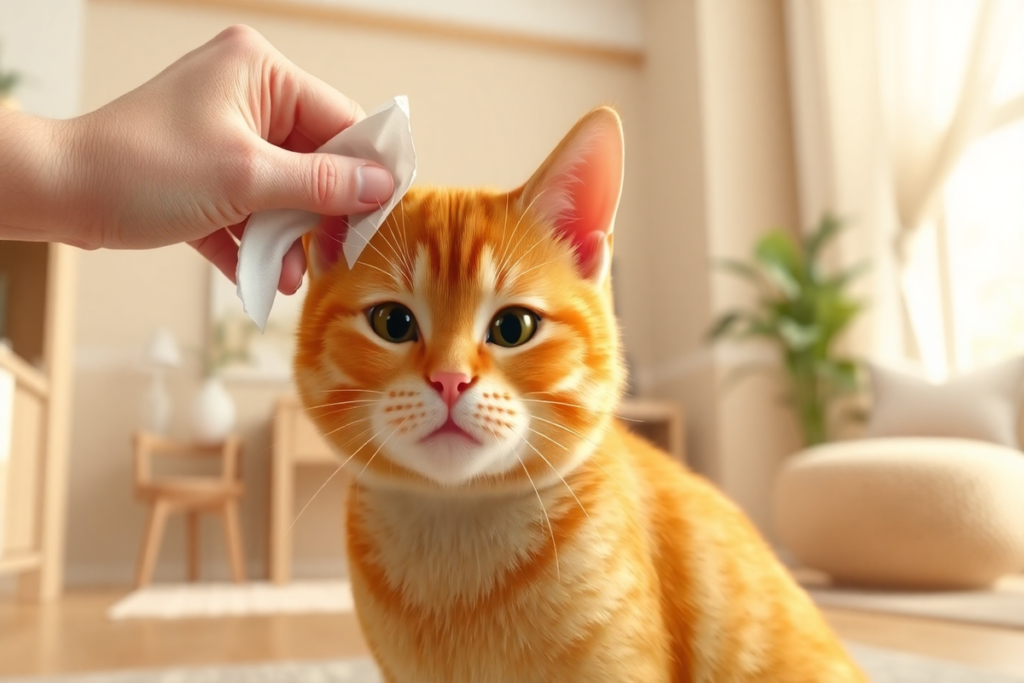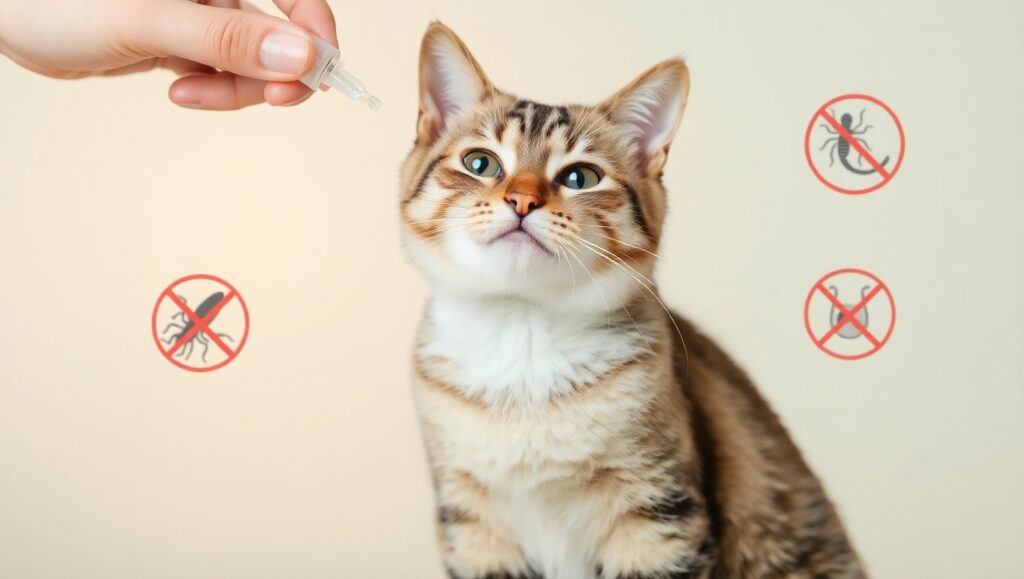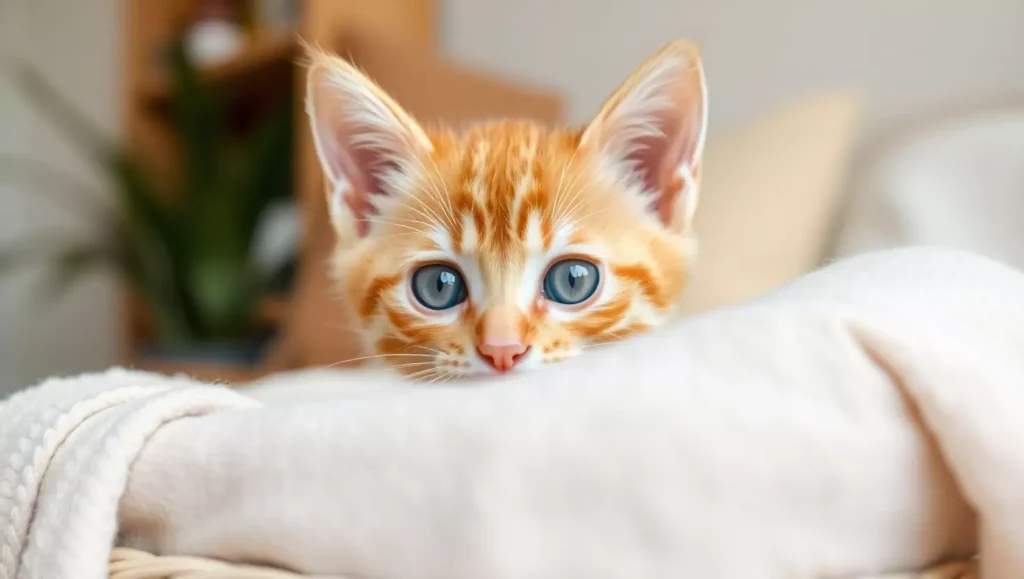Bathing a cat that hates water may seem like an impossible task, but sometimes it’s necessary. Cats are clean animals who groom themselves quite regularly. However, a flea infestation, contact with a toxic substance, or certain medical conditions may require thorough washing. Knowing when and why a cat needs a bath can help you avoid stress for both you and your cat.
With proper preparation and a calm approach, even the most water-repellent cats can take a bath safely and comfortably. Using a gentle technique, familiar settings, and adequate tools makes things so much easier. In this article, I will cover every step and provide stress-free alternatives, so you’ll never be unprepared.
Whether you are a new cat parent or facing grooming challenges, here is some practical, vet-recommended advice for bathing your cat with confidence.
Why Your Cat Hates Baths & When a Bath Is Truly Needed
When it comes to bathing, many cats will react with fear, stress, or aggression. By understanding the reasons behind this response, you can seek calmer, more feline-friendly methods for keeping them clean.
Self-Grooming Instincts
Cats are instinctive groomers; some estimates suggest they spend up to 50% of their waking hours licking and grooming their bodies. Their tongues are tiny, hook-shaped structures that help remove dirt, loose fur, and even parasites. Due to this obsessive hygiene, most cats have little natural inclination to take a bath, and the sensation of water can be strange, intrusive, and even frightening.
Only Necessary for Dirt, Fleas, or Medical Needs
You do not need to bathe your cat frequently. Excessive bathing can cause dryness of the skin and coat, and diminish the natural oils necessary for healthy fur. A bath is required if your cat has rolled in something sticky or toxic, has a heavy flea infestation, or if your veterinarian prescribes medicated baths for a skin condition.
Gentle Alternative Hygienic Options (Waterless Shampoo, Wipes)
If your cat is usually tidy, but there’s a small mess or some odor to deal with, then there are gentler options than a full bath. You can consider a waterless shampoo, grooming wipes specifically made for cats, or dry foams to help freshen them up, without too much hassle for you and without too much stress for your cat.
Apply these methods, which are more appealing to older cats, kittens, or those with medical issues that make getting wet dangerous.
Waterless shampoos: Waterless foams or sprays are easy to apply and wipe off. Select a calming blend that includes ingredients such as oatmeal, aloe vera, or coconut oil. Recommended include:
- Burt’s Bees Waterless Cat Shampoo – based on apple and honey, pH balanced
- Vet’s Best Waterless Cat Shampoo – has aloe and neem oil
- Wahl No-Rinse Shampoo – gentle, unscented foam made for sensitive skin
Cat Grooming Wipes: Hypoallergenic and fragrance-free wipes are ideal for quick cleanups and for cleaning dirt and fur between baths.
Routine Brushing: Frequent brushing removes excess hair, dirt, and dander, promoting a healthy coat by redistributing natural oils throughout the coat.
These methods are much less frightening and can be very useful for older cats or cats that are anxious by nature. With the correct supplies and some patience, you can keep your cat’s hygiene without traumatizing your pet during bath time.
Natural Instincts and Evolutionary Factors at Play
Cats originate from arid areas where they rarely encounter water. Their wild ancestors did not experience rainstorms or get soaked, so to a domestic cat, wetting goes against its instincts.
Wetting can give a cat a feeling of imbalance, making them less agile, cold, and vulnerable, all of which can increase stress levels. As stated in Scientific American, when a cat’s fur is wet, it disturbs their thermal regulation and brings discomfort.
Additionally, the odour of tap water or grooming products can be overpowering for those with sensitive noses. Their sense of smell has a strong influence on their sense of security; therefore, the bathing process strips their familiar natural scent and forces them to feel insecure.
If your cat looks anxious before washing has even started, consider these tips to help calm an anxious cat beforehand.
Why the Bathing Experience Can Feel Traumatic
Frequently bathing a cat can place it in a vulnerable situation, where it may feel trapped. The rush of water, slippery tubs, and strong smells can be overwhelming to a cat’s senses. Even if you are gentle, the cat may still perceive it as threatening.
Many cats also hate the loss of control. When they are restrained or cannot escape while being bathed, that leads to fear or panic. Once they feel fear, that bathroom will become a place they avoid at all costs, as they dread the possibility of a repeat of a previous experience.
Pre-Bath Preparation: Set the Stage for Success
When it comes to bathing your cat, proper preparation can make a huge difference. Understanding the process before starting will help make the bath go more smoothly for you and your cat.
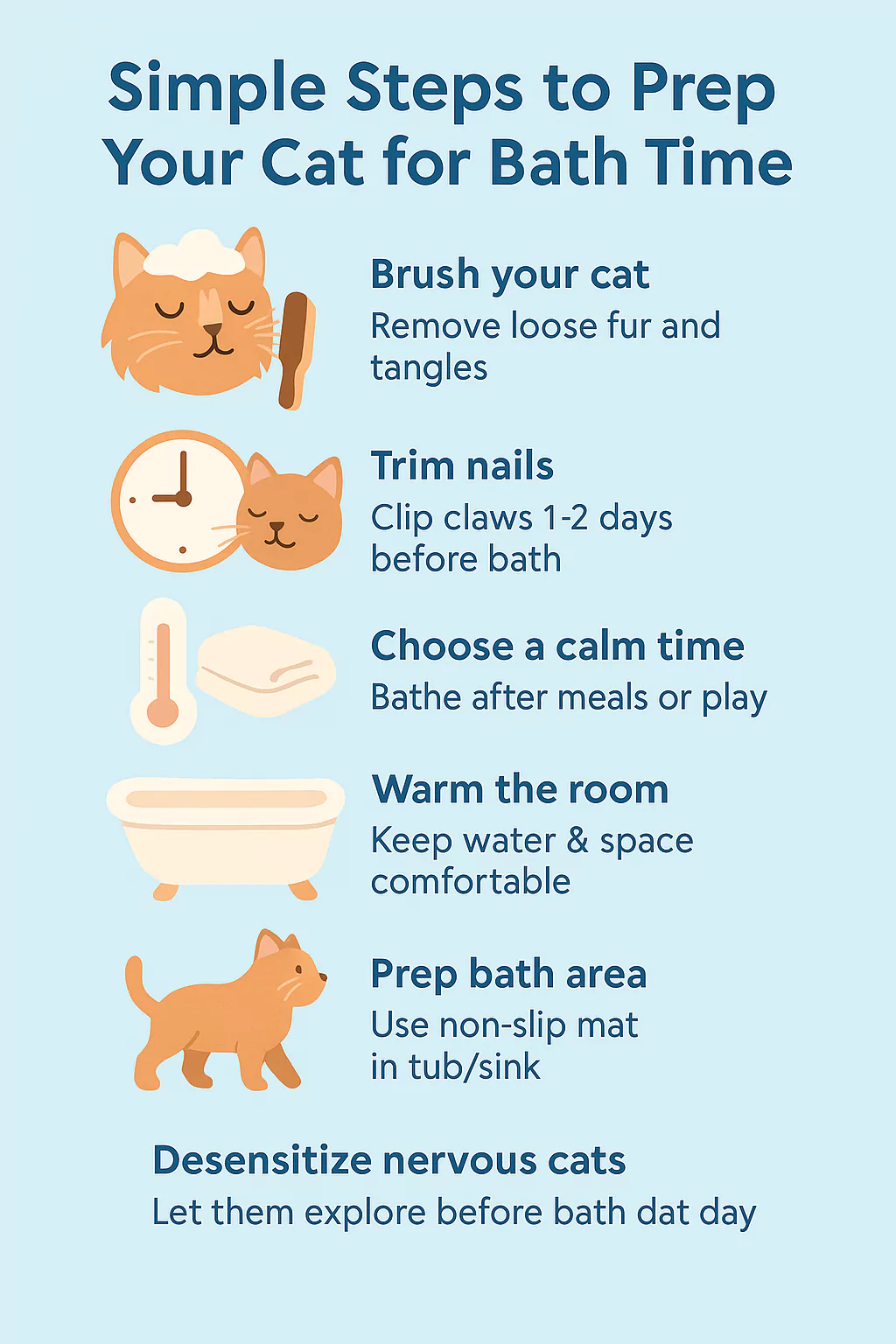
Trim Nails & Brush Out Fur to Remove Mats
Begin by trimming your cat’s claws to minimize the risk of scratches during the bath. Then, gently brush your cat to remove loose hair, tangles, and mats that can be tight and may cause pain when wet. This same process will also reduce the fur that ends up clogging your drain.
Create a Calming Environment After Playtime
Schedule the bath session after a playtime session, when your cat is likely to be tired and less likely to resist the bath. A relaxed, tired cat will be easier to handle and less likely to panic. To promote the calmest possible bath, consider using pheromone diffusers or sprays in the bathing area to help naturally reduce anxiety.
Use Non-Slip Mats, Towels & Have Supplies at Arm’s Reach
To prevent slips, place a rubber mat or towel at the bottom of the sink or tub to provide extra traction. Organize your materials – gentle, cat-safe shampoo, gentle sprayer or cup, towels, and treats ahead of time so you don’t have to leave your cat unattended. Having everything organized will help the experience go more smoothly both for you and your cat.
Understanding basic cat grooming and best practices will help you understand why cats tend to groom themselves, and baths should be infrequent.
How to Get Your Cat Comfortable with Water – Before Bath Time Begins
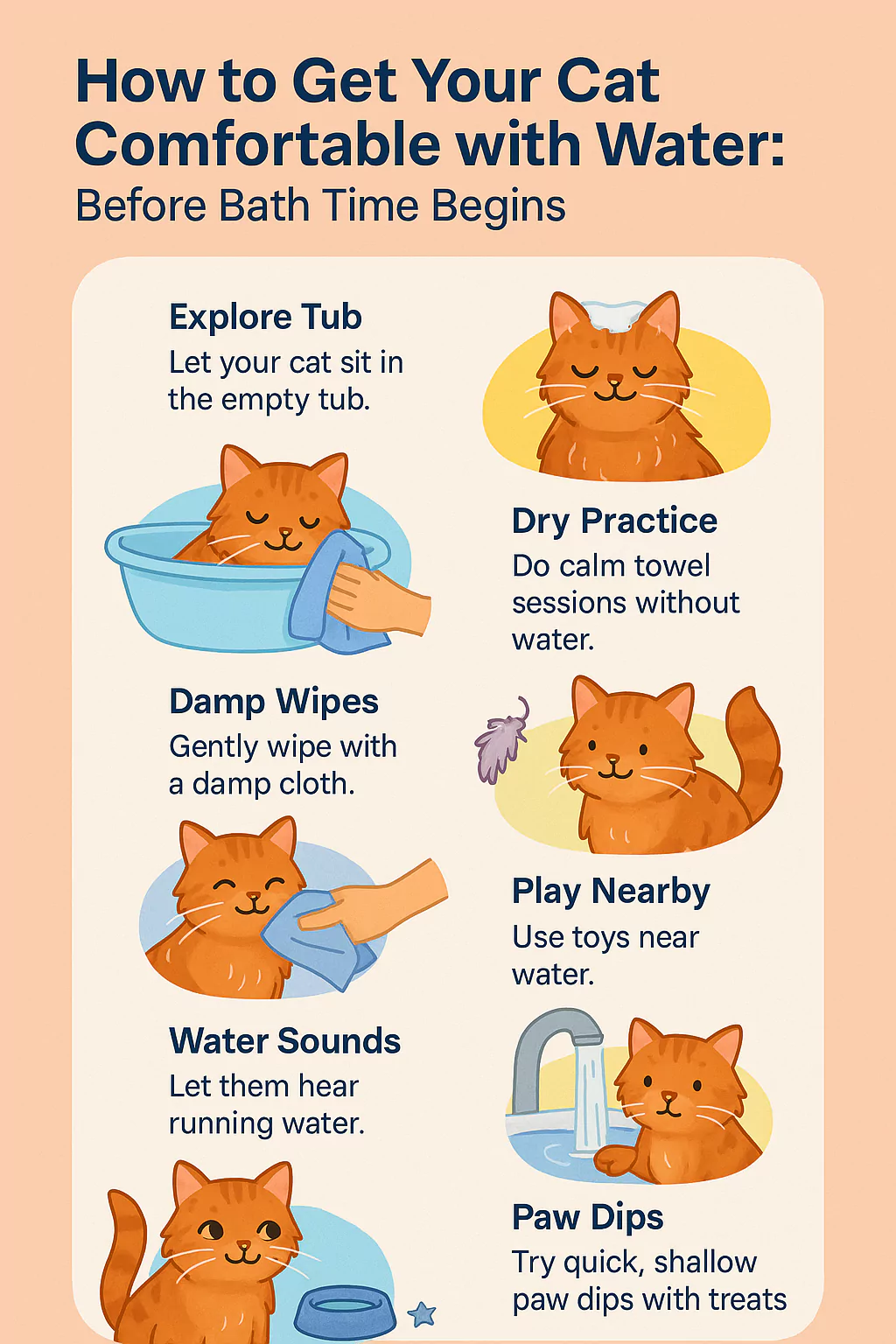
Dry-Run Sessions: Let Them Explore the Tub or Sink
Begin by allowing your cat to explore an empty sink or tub. Offer treats, gentle praise, or favourite toys to create a safe and non-threatening environment in the sink or tub. These short, low-pressure sessions can help your cat develop trust and alleviate fears surrounding bath time.
Introduce Gentle Touch with a Damp Cloth
As soon as your cat settles in the dry tub, start to gently wipe their back, paws, and tail with a damp, lukewarm cloth. This process mimics the experience of water without the shock of getting wet, so your cat has time to adjust to this sensation.
Let Them Observe Water Movement
Next, go over to the tub or sink and turn on the faucet at a slow drip. Allow your cat to observe or even interact with the water as they like. Some curious cats will paw at it or sit close by as they gradually become accustomed to the sight and sound of running water.
Add Shallow Water Gradually
Suppose your cat has relaxed behavior when around water. Fill the sink or tub with approximately an inch of lukewarm water. Carefully guide your cat into standing in the water; never force them. This step involves gently exposing your cat to water, rather than challenging its limits. Follow the water work with praise and rewards to build positive associations.
Reinforce with Positive Rewards
Remember to always include treats, gentle talk, or toys while taking your cat through this process. Positive reinforcement enables your cat to form positive memories associated with water and bathing areas, ultimately decreasing their likelihood of resistance or fear in the future.
Slowly Extend Exposure Over Time
As your cat becomes more tolerant, you can gradually increase the water level or even sweep and introduce your cat to gentle pouring with a cup. Respect your cat’s tolerance level and always offer short, gentle sessions, ensuring the cat does not feel trapped or overwhelmed at any time.
Learning about natural grooming behaviors helps explain why many cats are reluctant to use them and often refuse to engage in this behavior.
The Bath Process: Gentle Steps for Minimal Stress
When it’s time to bathe your cat, the most important thing to remember is to remain calm and approach the situation gently. In the section below, I’ll guide you step-by-step through the bathing process for your cat in a way that is most soothing and least anxiety-causing to your cat.
By creating a calm atmosphere and implementing cat-friendly techniques, you can make bath time less stressful for both of you.
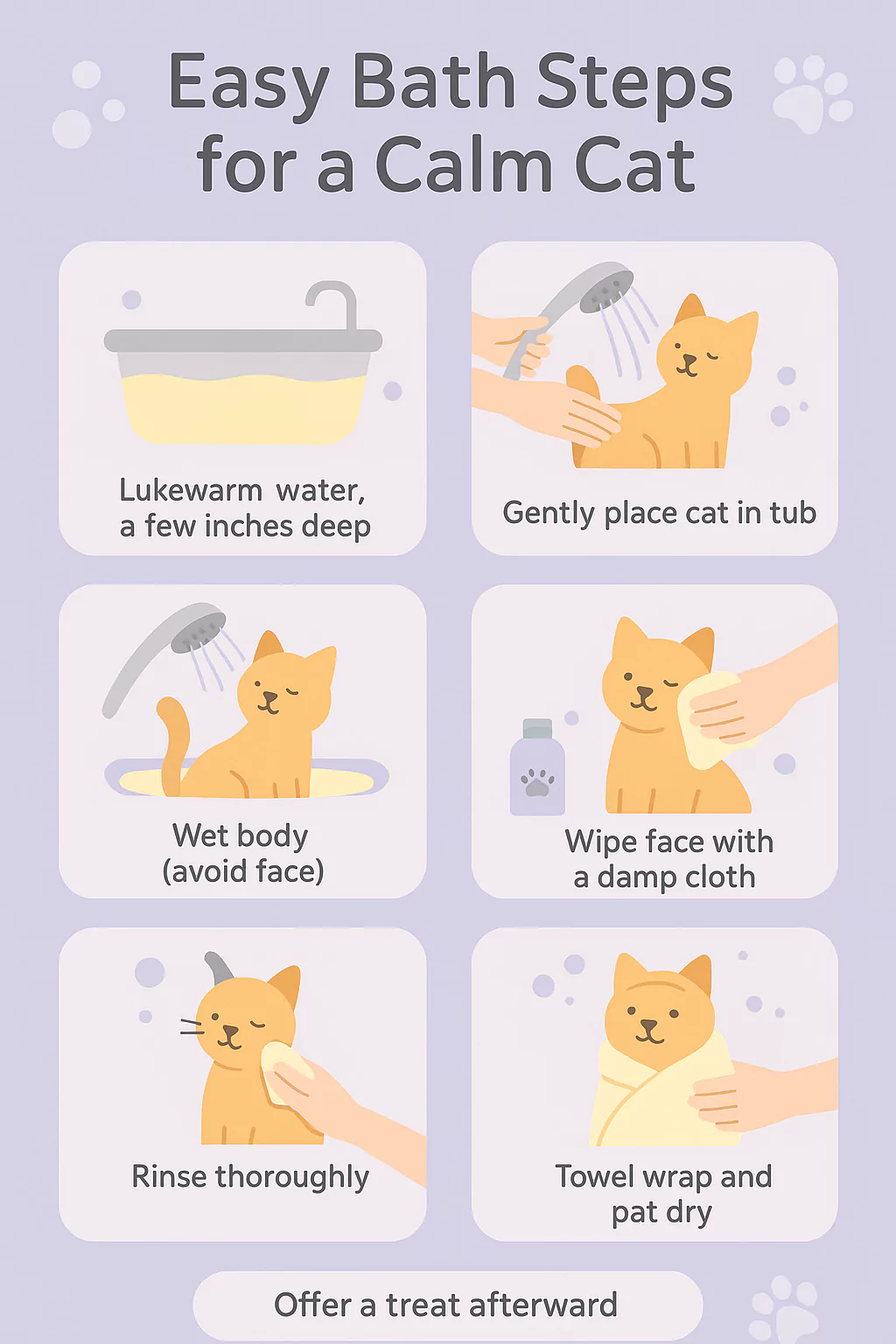
Use Lukewarm Water & Pour Slowly by Hand or Jug
Start with a few inches of lukewarm water in the bathtub or sink, enough to wet your pet’s lower body but not so much that it frightens them. Use a cup or small jug to slowly and gently pour water over your cat. Try to avoid sudden movements or loud noises that may startle your cat.
Apply Cat-Safe Shampoo with Gentle Massage, Avoid Face & Ears
Select a shampoo specifically designed for cats to protect their sensitive skin. Apply it to the fur by gently massaging it in, ensuring a quiet and soothing touch. Avoid touching any areas on the face, ears, or eyes, as this can cause irritation or further discomfort.
Rinse Thoroughly to Prevent Irritation
Any excess shampoo may cause itching or skin irritation, so it is essential to rinse thoroughly. Rinse your cat’s coat carefully with clean, warm water, and work roughly to remove all the shag and other suds. A regular grooming pattern is easier to follow when you adhere to these basic tips for cat care, especially for beginners.
Drying and Aftercare: Wrapping Up Carefully
Dry with a Soft Towel
After bathing, carefully pick up your cat and wrap them in a warm, fluffy towel. Gently blot the fur to absorb excess water. Do not rub the fur to soak up water, as this can cause tangles and a troublesome experience for your cat. If your towel becomes too wet, switch to a dry towel to continue.
Use a Hair Dryer, Only If Your Cat Allows It
If your cat remains calm, you can use a hair dryer on the lowest heat and quietest setting, always holding it more than 12 inches away from the fur. Ensure you move the hairdryer constantly, as you do not want to create heat buildup on your cat’s skin. Also, stop using the hair dryer at any sign of stress. Otherwise, you can let your cat air dry in a warm, quiet room.
Provide Comfort: Treats, Praise, and a Cozy Recovery Spot
After your cat is dry, provide soft praise, a favorite treat, and soothing pats. Set up a warm, quiet area with blankets for your cat to groom and relax in. Keeping things calm as you dry and praise your cat helps your cat associate bath time with safety and care.
Hiring a Professional Groomer or Vet Service
For cats with severely matted fur, excessive dirt, or behavioral challenges, professional groomers or technicians at the veterinarian clinic, trained in cat grooming, would be best. They can safely utilize grooming techniques and tools to calm the cat and create a less stressful grooming experience. That way, your cat can be clean without additional fear or risk.
Maintenance Tips & Reduced-Stress Grooming Over Time
Regular grooming is essential for your cat’s well-being and comfort, and it doesn’t require water. In this section, you will learn valuable maintenance tricks to help reduce matting, manage shedding, improve the condition of your cat’s coat, and keep your cat comfortable. A proper grooming routine can reduce stress and minimize the need for frequent full baths.
Establishing respect for your cat’s comfort level fosters a deeper bond and promotes signs that your cat trusts you more regularly when you groom it.
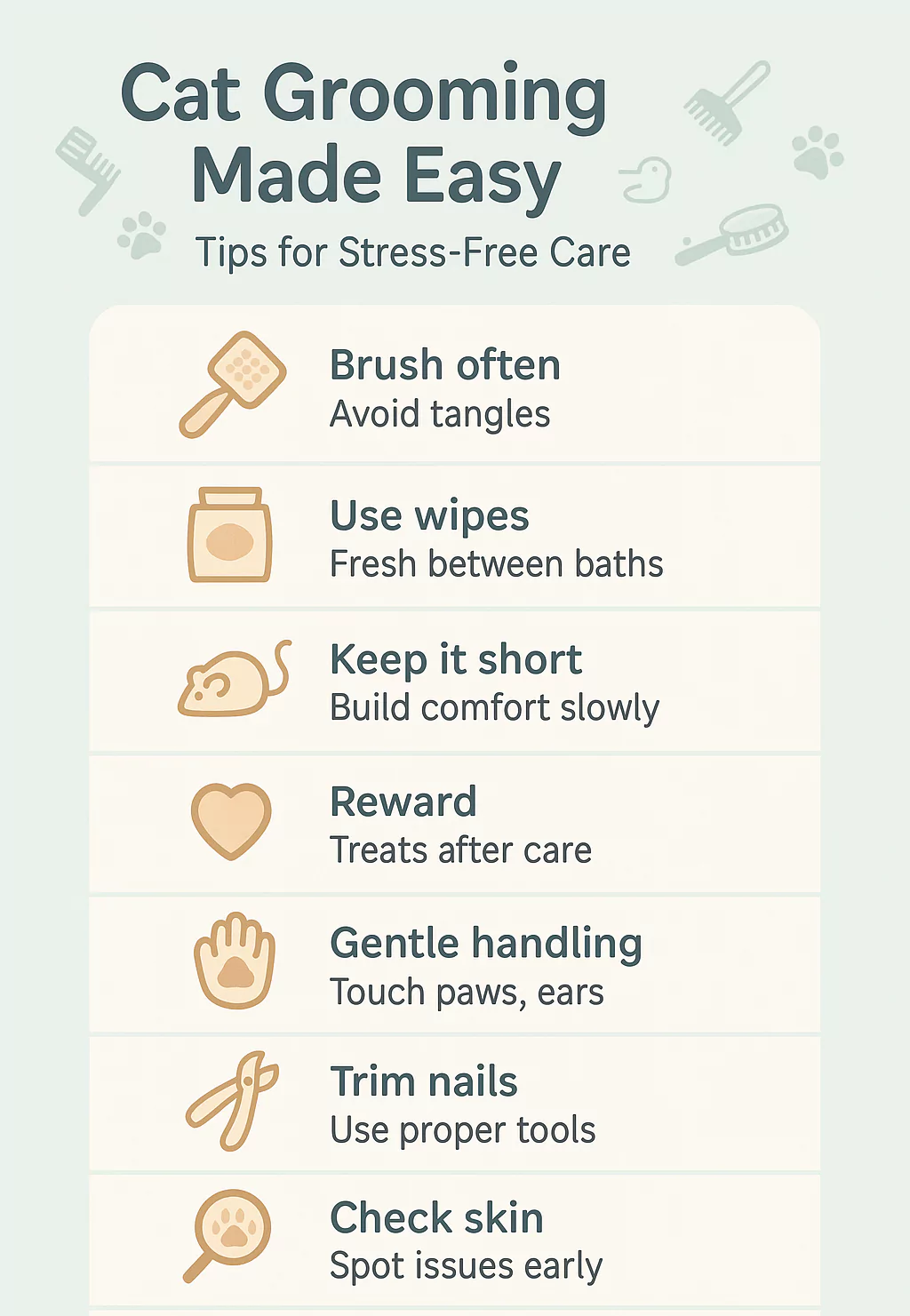
Brush Regularly Between Baths
Combing your cat’s coat regularly, every few days, helps remove loose hair and minimizes the formation of tangles or mats. It helps to decrease hairballs and keeps their skin healthy by promoting the natural distribution of oils. Use a brush that is suitable for your cat’s coat length to make it a soothing and pleasurable experience.
Use Calming Techniques Consistently
Consistent routines help your cat feel safe, stay calm, and remain still in your movements, allowing them to groom in a similar context each time. Start with brief sessions and gradually increase the time spent grooming. Treats and affection can also help build these positive associations over time.
Monitor Skin, Coat, and Behavior
Examine your cat’s coat for any signs of dryness, flaking, bald spots, or injuries, and observe their grooming behavior. If your cat is increasingly grooming itself by licking excessively or avoiding brushing, it may be a sign that the cat is in pain or stressed. In either event, addressing the early signs of excessive grooming allows you to identify potential health issues quickly.
Trim Nails Regularly and Safely
Routine nail trimmings help prevent painful snags or breaks, while also protecting your furniture and skin from damage. Use cat-specific nail clippers and trim just the sharp tip of the nail. If your cat seems anxious, trim one paw at a time, allowing breaks with treats or praise.
Clean Ears and Eyes Gently
Use a wet, soft cloth or veterinary-approved wipes to gently wipe around your cat’s eyes and ears periodically. Do not insert anything deep inside the ear canal. Cleaning gently often helps prevent debris and buildup, as well as potential irritation or infection, without stressing your cat.
Practice Handling Between Grooming
Familiarize your cat with being handled by touching their paws, ears, and tail when playing or cuddling. Calm, regular contact will help your cat be less fearful of grooming or vet visits. Remember to always reward with love or a small treat.
Maintain a Calm Environment
Maintain a calm atmosphere by keeping your grooming sessions quiet, avoiding loud noises and sudden movements. Use a non-slip surface and soft lighting to create a peaceful environment where your cat can relax and remain in a calm state. By creating a quiet environment, your cat will have the opportunity to trust you and become more comfortable with grooming over time.
Stay Patient and Positive
Every cat will adjust to grooming at their own pace. Some cats may take weeks, while others take months. It is essential to have patience and be content with the small successes of each cat. Please never punish or force grooming. A cat will carry that fear of punishment for a long time. Positive reinforcement always works best.
Taking a calm approach and using treats to reward appropriate behaviour will go a long way in helping you learn how to make cat bathing a pleasant experience, even for nervous cats.
FAQ
How often should I bathe my cat?
Most cats only need baths every few months or when necessary. Cats are naturally clean animals, and they don’t typically need baths often. A bath is only necessary if your cat is visibly dirty, smelly, or has flea and skin infections. Bathing cats, too, usually can strip their coats of natural oils and cause irritation, so it’s best to avoid it. Therefore, it is best to bathe cats every few months or as necessary.
Can I use human shampoo?
No, human shampoo is not safe for cats. No, human shampoo, even baby shampoo, is not safe for cats. Cats have a different pH level in their skin. When you wash a cat’s fur with human products, it can disrupt their pH level and cause dryness, or even allergic reactions. Always use a shampoo specifically designed for cats to ensure their safety and comfort.
What if my cat panics despite prepping?
Stop immediately and try again in a few days. If your cat becomes excessively stressed or aggressive during bathing, stop immediately. Attempting to force a bath will break the bond and could lead to a fearful association and anxiety. Wait a few days and try again. There are several ways to acclimate your cat slowly, using positive reinforcement, or you can seek help from a groomer or veterinary technician.
Is it okay to bathe a kitten?
Yes, but be extra careful with lukewarm water and gentle shampoo. Yes, but you have to be extra careful. Kittens are delicate creatures and can become quickly chilled, so be sure to have lukewarm water and a gentle shampoo that is safe for kittens. Dry them thoroughly afterwards. Avoid getting water near the face and ears, and make the experience a short, structured, calming experience so they are not overwhelmed.
How can I make baths less stressful in the long term?
Desensitize your cat gradually with positive reinforcement and treats. Desensitize your cat in stages by introducing bath parts over time. Allow the cat to explore an empty tub, and praise calm behavior with treats to build a good association. Let the cat out at any time, until you feel the cat is ready for the next step. Regular brushing and gentle handling, which fosters a bonding touch, will also help your cat accept grooming visits with less fear, better preparing the cat for a bath.
Conclusion
Bathing your cat can seem like a challenge, but with proper preparation, a little patience, and the right approach, it can be a safe and comfortable experience for both of you. Knowing your cat’s personality, having the right tools, and incorporating soft techniques will help immensely.
Just keep in mind that most cats do not require regular baths; regular brushing and occasional spot cleaning are usually sufficient. When it is time for a bath, remaining calm and being respectful of your cat’s comfort is essential for building trust and ensuring safety. And if you are ever in doubt, consider professional grooming to relieve your cat of some stress.
With regular attention, grooming can become quality time for both of you and help support your cat’s health, hygiene, and happiness.



